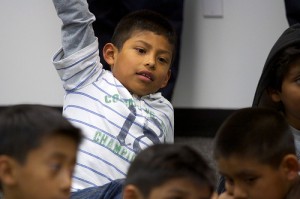This more holistic approach has helped Think College Now build better relationships with the school’s low-income and immigrant families, many of whom lack broadband access at home.
“For some schools without such a big digital divide, they might be able to rely on parents doing more work with the videos at home,” she said. “But it was important for us to combine the videos with workshops and one-on-one coaching at school.”
More than 7,500 parents have tested the 100 College Bound videos across the country, including Think College Now and several others in the Bay Area. The videos are made in both English and Spanish, targeted to low-income and immigrant parents of children between kindergarten and fifth grade who may find they have trouble communicating school-related skills to their children.
“Parents have just as much impact on a child’s education as schools do,” said GreatSchools CEO Bill Jackson. "We are trying to figure out a balance between preaching to parents, because nobody wants a cartoon character telling them what a bad parent they are. But we also want to help improve parenting competencies if parents think they need help.”
But taking into account the particular needs of minority parents, especially immigrant families, has been a challenge when creating these videos, according to Guadalupe Valdes, a professor of education at Stanford University and an adviser to GreatSchools. Valdes said the first versions of the College Bound videos have struggled to maintain that “cultural sensitivity.”
“I think they tried by making Spanish language versions,” she said, “but cultural sensitivity goes beyond language. The underlying assumption seems to be that if minority parents carry out some of the practices that have led to success for majority families, that will be good for them.”
Still, Valdes said the videos could be a way for willing parents to learn about what teachers and schools expect from them in supporting their children at home.
Great Schools plans on continuing more pilot programs of the videos next school year in more schools. Jackson said he hopes to expand parents’ choices for what videos they watch with the aim of being more responsive to individual needs.
“One parent might have trouble getting their kid to do homework,” he said, “and for another parent it might be that their kid is always bored. We want to tailor our videos to whatever the parents are thinking about and not make it a laundry list of skills you have to click through.”
The videos have helped Abellanira Santos, a mother of three, who was having difficulty convincing her middle child Maria Victoria to go to bed before 10 pm. So she sat down with the kindergartner and began counting the number of hours Maria Victoria slept each night.
“I showed her how many hours she would get to sleep if she went to bed at eight than if she went to bed at 10 or 11,” Santos said. “I told her it would help her in school if she got more hours of sleep, and she got excited as we started counting the hours.”
Now, Maria Victoria, who attends Think College Now Elementary, hardly ever puts up a fight at bedtime. Santos said she learned new strategies for talking to her daughter about bedtime from watching the College Bound videos.
Abellanira Santos recently got a personal computer and watches the videos at home as Maria Victoria sits on her lap. “I sometimes feel like I need a little review,” she said.
[UPDATE 6/15/12]: CEO of GreatSchools Bill Jackson would like to add the following quote regarding parents: “We don’t want to preach to them about what they should do. Parents are doing a lot already. Instead we offer them a place to get the information, inspiration and the social support they’re seeking to raise children who will succeed in school and emerge ready for the world.”


